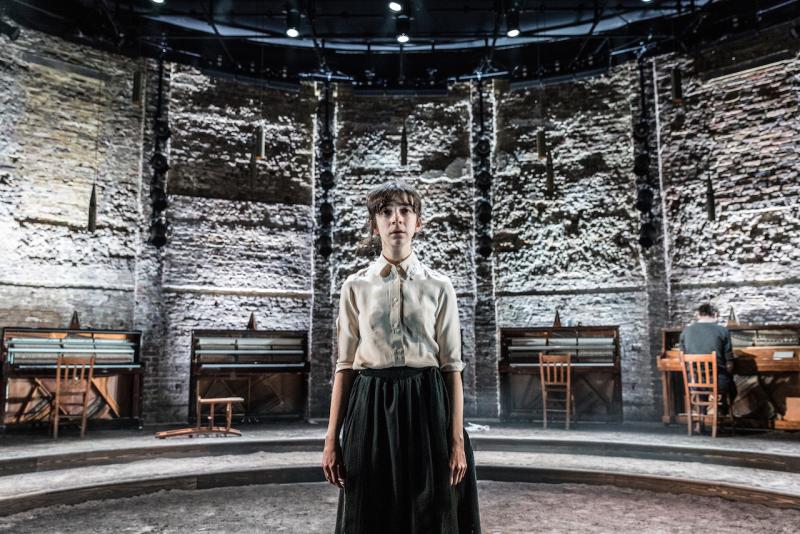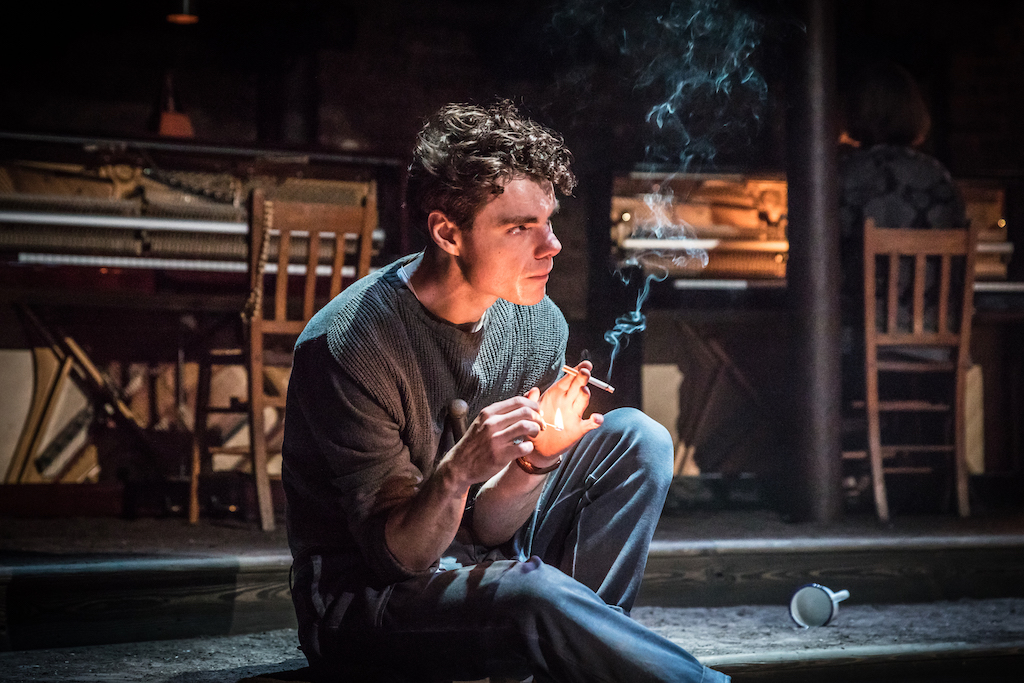Summer and Smoke, Duke of York's Theatre review – Patsy Ferran's remarkable performance | reviews, news & interviews
Summer and Smoke, Duke of York's Theatre review – Patsy Ferran's remarkable performance
Summer and Smoke, Duke of York's Theatre review – Patsy Ferran's remarkable performance
West End transfer from the Almeida retains pressure-cooker intensity

This production of Tennessee Williams’ neglected classic, Summer and Smoke, arrives from the Almeida into the West End with five-star plaudits for its pitch-perfect performances and pressure-cooker intensity.
It is a pleasure to be able to report, therefore, that Rebecca Frecknall’s boldly expressionist production – with its electrifying soundscape – galvanises the audience from the start. Seven upright pianos, their strings and hammers exposed like animals’ innards, stand in a semi-circle at the back of the stage. From the shadows, performers emerge to create an urgent, hammering refrain that builds in intensity as a woman standing at a microphone gulps and hyperventilates her way through panic that seems to rock her like an earthquake.
It’s the first moment that you realise that, for all its fine ensemble work, this evening is going to be defined by a quite remarkable performance from Patsy Ferran as the uptight minister’s daughter, Alma Winemiller. Summer and Smoke is not subtle symbolically – the name Alma means "soul" while John, the young dissolute doctor’s son with whom she falls in love, worships anatomy both in and out of textbooks – yet Ferran’s raw sensitivity ensures every note rings true.
We are all essentially living inside Alma's head
That’s not least due to the physical comedy that she extracts from her character being as tense as a piano wire. When Matthew Needham’s lanky, drawling doctor’s son (pictured below) identifies Alma as a hysteric, her indignation contorts her, when she giggles, it sounds like there are solid bubbles in her throat. Her arms, clamped stiffly to her sides, seem hinged sharply at the elbows as her hands fly around like panicked birds, while her face, when she is dismayed, radiates both bleak beauty and comic desolation.
Yet we are moved by her throughout, and that’s not just because Frecknall’s brilliant expressionist twist means we are all essentially living inside Alma’s head. It’s also due to our being able to see that she is attracted to John not despite his being her opposite, but precisely because he is her opposite. One of the most incandescent moments – where lighting and sound design fuse perfectly with the play’s emotions – is when Alma and John, teetering dangerously on the verge of cliché, watch a firework display together. The potential absurdity is beautifully offset by other cast members recreating the whistle of the fireworks, before an explosion of sound is matched by an explosion of light within the pianos, and the physical impact resonates on a whole other level. Both Alma and John are buckled under the weight of parental expectations – Alma by her demanding clergyman father, who needs her as a substitute spouse now his wife is mentally ill, and John by a father who is an idealistic doctor. It’s a great bit of double casting, then, to make Forbes Masson play both men as different kinds of emotional tyrants, equally responsible for their children’s insecurities. Nancy Crane also distinguishes herself as Alma’s mother, made simultaneously decadent and spiteful by her dementia. And in another example of clever multiple casting, Anjana Vasan compellingly embodies the confident sensuality of the women in John’s life who act in counterpoint to Alma’s buttoned-up virginity.
Both Alma and John are buckled under the weight of parental expectations – Alma by her demanding clergyman father, who needs her as a substitute spouse now his wife is mentally ill, and John by a father who is an idealistic doctor. It’s a great bit of double casting, then, to make Forbes Masson play both men as different kinds of emotional tyrants, equally responsible for their children’s insecurities. Nancy Crane also distinguishes herself as Alma’s mother, made simultaneously decadent and spiteful by her dementia. And in another example of clever multiple casting, Anjana Vasan compellingly embodies the confident sensuality of the women in John’s life who act in counterpoint to Alma’s buttoned-up virginity.
Although the evening teeters on tragedy – one of its most extraordinary moments, beautifully lit by Lee Curran, is when John’s father is fatally shot – we are allowed to see Alma’s turbulent journey end with a whisper of redemption. It’s just one high note in a complex symphony of emotion that shows us that, for all John’s emphasis on anatomy, it’s as ever the inexplicable aspects of the human heart that are truly transformative.
- Summer and Smoke at the Duke of York's Theatre till 19 January 2019
- Read more theatre reviews on theartsdesk
rating
Explore topics
Share this article
The future of Arts Journalism
You can stop theartsdesk.com closing!
We urgently need financing to survive. Our fundraising drive has thus far raised £49,000 but we need to reach £100,000 or we will be forced to close. Please contribute here: https://gofund.me/c3f6033d
And if you can forward this information to anyone who might assist, we’d be grateful.

Subscribe to theartsdesk.com
Thank you for continuing to read our work on theartsdesk.com. For unlimited access to every article in its entirety, including our archive of more than 15,000 pieces, we're asking for £5 per month or £40 per year. We feel it's a very good deal, and hope you do too.
To take a subscription now simply click here.
And if you're looking for that extra gift for a friend or family member, why not treat them to a theartsdesk.com gift subscription?
more Theatre
 Troilus and Cressida, Globe Theatre review - a 'problem play' with added problems
Raucous and carnivalesque, but also ugly and incomprehensible
Troilus and Cressida, Globe Theatre review - a 'problem play' with added problems
Raucous and carnivalesque, but also ugly and incomprehensible
 Clarkston, Trafalgar Theatre review - two lads on a road to nowhere
Netflix star, Joe Locke, is the selling point of a production that needs one
Clarkston, Trafalgar Theatre review - two lads on a road to nowhere
Netflix star, Joe Locke, is the selling point of a production that needs one
 Ghost Stories, Peacock Theatre review - spirited staging but short on scares
Impressive spectacle saves an ageing show in an unsuitable venue
Ghost Stories, Peacock Theatre review - spirited staging but short on scares
Impressive spectacle saves an ageing show in an unsuitable venue
 Hamlet, National Theatre review - turning tragedy to comedy is no joke
Hiran Abeyeskera’s childlike prince falls flat in a mixed production
Hamlet, National Theatre review - turning tragedy to comedy is no joke
Hiran Abeyeskera’s childlike prince falls flat in a mixed production
 Rohtko, Barbican review - postmodern meditation on fake and authentic art is less than the sum of its parts
Łukasz Twarkowski's production dazzles without illuminating
Rohtko, Barbican review - postmodern meditation on fake and authentic art is less than the sum of its parts
Łukasz Twarkowski's production dazzles without illuminating
 Lee, Park Theatre review - Lee Krasner looks back on her life as an artist
Informative and interesting, the play's format limits its potential
Lee, Park Theatre review - Lee Krasner looks back on her life as an artist
Informative and interesting, the play's format limits its potential
 Measure for Measure, RSC, Stratford review - 'problem play' has no problem with relevance
Shakespeare, in this adaptation, is at his most perceptive
Measure for Measure, RSC, Stratford review - 'problem play' has no problem with relevance
Shakespeare, in this adaptation, is at his most perceptive
 The Importance of Being Earnest, Noël Coward Theatre review - dazzling and delightful queer fest
West End transfer of National Theatre hit stars Stephen Fry and Olly Alexander
The Importance of Being Earnest, Noël Coward Theatre review - dazzling and delightful queer fest
West End transfer of National Theatre hit stars Stephen Fry and Olly Alexander
 Get Down Tonight, Charing Cross Theatre review - glitz and hits from the 70s
If you love the songs of KC and the Sunshine Band, Please Do Go!
Get Down Tonight, Charing Cross Theatre review - glitz and hits from the 70s
If you love the songs of KC and the Sunshine Band, Please Do Go!
 Punch, Apollo Theatre review - powerful play about the strength of redemption
James Graham's play transfixes the audience at every stage
Punch, Apollo Theatre review - powerful play about the strength of redemption
James Graham's play transfixes the audience at every stage
 The Billionaire Inside Your Head, Hampstead Theatre review - a map of a man with OCD
Will Lord's promising debut burdens a fine cast with too much dialogue
The Billionaire Inside Your Head, Hampstead Theatre review - a map of a man with OCD
Will Lord's promising debut burdens a fine cast with too much dialogue

Add comment